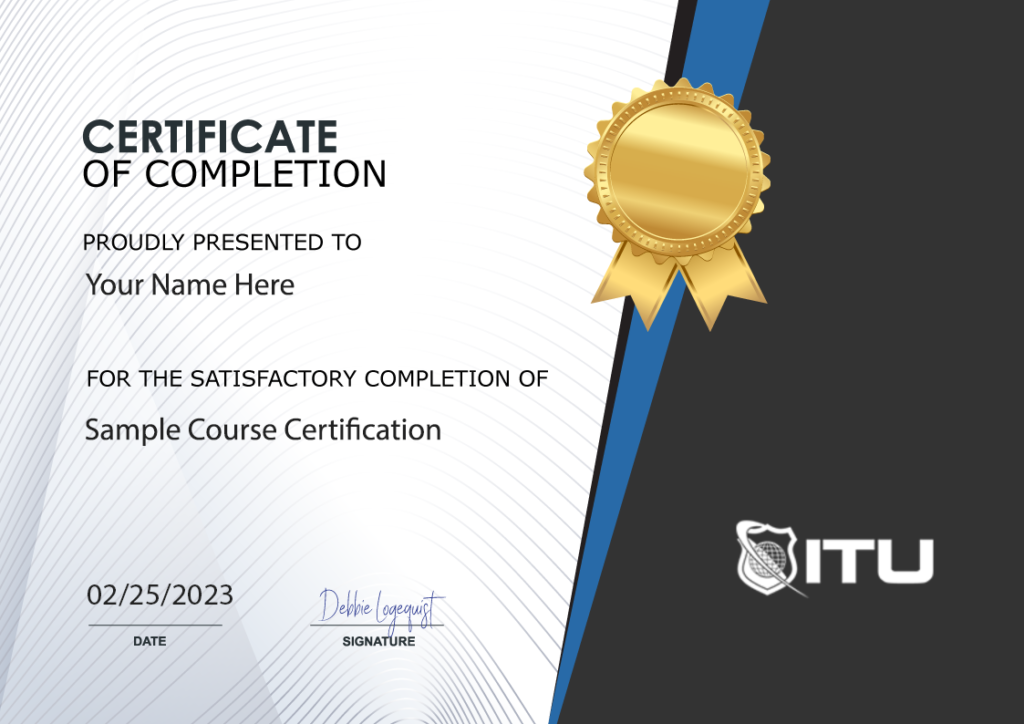
Lifetime
An ITU Online Training exclusive. The only Buy Once, Never Pay for IT training again program available. Plus, get all new and updated content for life.

With an All-Access Pass, you get access to every current and future ITU course. Access over 2,500 hours of on-demand IT Training 24/7. With over 13,000 on-demand training videos and 19,000+ practice questions, you'll have the tools to excel in the critical IT skills needed to elevate your IT Career. Our All-Access pass is available in three affordable plans.
Paris is the capital of France.
Tokyo is the capital of Japan.
Most Popular
Categories

With an All-Access Pass, you get access to every current and future ITU course. Access over 2,500 hours of on-demand IT Training 24/7. With over 13,000 on-demand training videos and 19,000+ practice questions, you'll have the tools to excel in the critical IT skills needed to elevate your IT Career. Our All-Access pass is available in three affordable plans.

ITU provides a vast array of IT-focused on-demand training designed to help you excel in both entry-level and advanced IT skills. Browse our most popular training or take a deper dive into our robust catalog of training categories.
Popular Courses All Categories




Become a must-have IT professional by taking this comprehensive DevOps training course geared towards the Google Cloud Platform (GCP) This comprehensive bundle includes 8 courses, along with 3 bonus courses: CompTIA Cloud Essentials and CompTIA Cloud+, and Introduction to Python.
Included In This Course
Closed Captions
Certificate of Completion
Course Description
DevOps training isn’t only fun but is fast becoming a critical job function as an IT professional. This Google DevOps Training Series is geared toward the Google Cloud Platform (GCP) will best benefit programmers who want to deploy applications on GCP (the Google Cloud Platform), Cloud managers, Cloud administrators, Cloud architects, solution architects, and Cloud developers.
Embark on a Transformative Learning Journey
Join the ranks of IT professionals mastering the Google Cloud Platform (GCP) with ITU Online’s DevOps Training Online Series. This series is more than just a learning experience—it’s a crucial step towards a successful IT career in cloud computing.
Comprehensive Course Bundle for Aspiring Cloud Experts
Our 8-course bundle, enriched with three bonus courses including CompTIA Cloud Essentials, CompTIA Cloud+, and an Introduction to Python, is tailored to advance your data engineering career. Prepare for the Google Cloud Professional DevOps Engineer certification with confidence, joining the 87% of certified professionals who report increased cloud expertise.
Tailored for a Wide Range of IT Professionals
This series is ideal for programmers, cloud managers, administrators, architects, and developers focused on deploying applications on GCP. It’s an indispensable resource for anyone in IT looking to specialize in cloud-based DevOps environments.
Fast-Track Your Success in Cloud Engineering
Gain the skills and knowledge needed to excel in cloud devops engineering. Prepare for the Google Cloud Professional Cloud DevOps Engineer exam with our targeted, in-depth training.
Maximize Performance with Site Reliability Engineering Principles
Learn how to enhance your Google Cloud infrastructure and applications. Our course focuses on monitoring, troubleshooting, and improving based on Site Reliability Engineering (SRE) principles.
Comprehensive Training for Real-World Application
With 49 hours of training, 546 on-demand videos covering 88 topics, and 357 prep questions, our course is designed to provide a thorough understanding of DevOps methodologies, perfect for IT professionals in the cloud computing field.
A Course for Every IT Professional
Whether you’re a programmer eager to deploy applications on GCP, a cloud manager, administrator, architect, or developer, this course is designed for you. Enhance your DevOps skills specifically for the Google Cloud Platform.
Beginner-Friendly and Advanced-Level Relevance
Suitable for both newcomers and experienced professionals in the IT sector, this series offers the knowledge and tools necessary to succeed in the fast-paced world of cloud computing and DevOps.
Broad Appeal for a Diverse Audience
ITU Online’s DevOps Training Online is a versatile and comprehensive program, ideal for IT professionals seeking to excel in cloud computing and DevOps.
The Google DevOps Training Series is a comprehensive DevOps training course that’s specifically designed for the Google Cloud Platform (GCP). This bundle includes eight main courses and three bonus ones: CompTIA Cloud Essentials, CompTIA Cloud+, and an Introduction to Python.
The Google DevOps Training Series includes 49 hours of training. This is delivered through 546 on-demand videos covering 88 different topics. There are also 357 prep questions to help you solidify your understanding.
This course is perfect for programmers who want to deploy applications on GCP, as well as cloud managers, administrators, architects, solution architects, and developers. Basically, if you’re an IT professional looking to enhance your DevOps skills specifically for the Google Cloud Platform, this course is for you.
By taking this course, you’ll not only elevate your success in cloud DevOps engineering but also prepare yourself for the Google Cloud Professional Cloud DevOps Engineer exam. The course is designed to help you maximize the performance of your Google Cloud infrastructure and applications by teaching you monitoring, troubleshooting, and improvement approaches based on Site Reliability Engineering (SRE) principles. Plus, you’ll gain a thorough understanding of essential job skills like constructing software delivery pipelines and deploying/monitoring services on Google Cloud.
The course is designed to equip you with the necessary skills and knowledge to succeed on the Google Cloud Professional DevOps Engineer certification exam. This certification is a great addition to your resume and can boost your confidence in your cloud abilities, as reported by 87% of those certified by Google Cloud.
Absolutely! Along with the eight main courses, you’ll also get access to three bonus courses: CompTIA Cloud Essentials, CompTIA Cloud+, and an Introduction to Python. These extra resources will give you an even more well-rounded understanding of the cloud and DevOps.

Course Outline
Joe Holbrook has been in the IT field since 1993 when he was exposed to several HPUX systems on board a U.S. Navy flagship. He has migrated from UNIX world to Storage Area Networking(SAN), Enterprise Virtualization, Cloud Architectures, and now specializing in Blockchain and Cryptocurrency. He previously worked for numerous companies like HDS, 3PAR, Brocade, HP, EMC, Northrup Grumman, ViON, Ibasis.net, Chematch.com, SAIC and Siemens Nixdorf.
Currently he works as a Subject Matter Expert specializing in Enterprise Cloud and Blockchain Technologies. He is the CLO of Techcommanders.com Elearning and consulting, He holds numerous IT certifications from AWS, GCP, HDS and other organizations.
He is an avid speaker and well-known course author residing in Jacksonville, Florida.
David has been a professional IT instructor for the past four years for the US Army. He teaches a broad range of certification courses ranging from CompTIA, Microsoft to Cisco and EC-Council. Prior to working with the US Army, David worked as a Jr. Network Admin and Web Services Manager with KCTCS in Kentucky. He performed multiple jobs being on the IT team. Additionally, David taught part-time during the evening at the college, where he instructed on Active Directory, Introduction to Computers, and Networking. David has 18 years of IT experience, 17 professional IT certifications, and 8 years of teaching experience.
Dawn Briggs is an information technology professional with more than 20 years of experience in directing IT departments, leading technical implementations, managing personnel, ensuring the security of information, and establishing high customer service standards. Although she has a broad range of experience across the IT industry that includes everything from pc repair to database management, her career has primarily focused on training technical personnel to plan, implement, and maintain IT infrastructure and web-based technologies. Dawn has been instructing students in IT courses, and mentoring students in skills that allow them to obtain jobs in information technology career fields, for over seven years.
$49.00
Gain access to this training and all our other courses, offering over 2,500 hours of content, with our cost-effective monthly subscription. No obligations. Cancel anytime.

Monthly All-Access Subscription
7 Days Free - $39.00 / month
A great option at an affordable monthly price.
Annual All-Access Subscription
$229 / year
A discounted price when paying for your All Access library on an annual basis.
Lifetime All-Access Library
$379 One time payment
Exceptional Value. Pay once, never have to buy IT training again.
$49.00
With the ITU course bundle, students will gain a competitive edge by unlocking the full potential of Windows 10. The comprehensive Microsoft Windows 10 Power User course provides valuable insight into using this platform effectively and efficiently so that novices can become power users in no time at all! Through hands-on training and engagement with experts, you’ll be well on your way to mastering Windows 10 before you know it.
$49.00
In this course you will learn how to plan and design Sharepoint sites, implement authorization and authentication, access and manage data, implement Sharepoint solutions, implement the user experience and information architecture, create business processes, and create office applications.
$49.00
ITUs course is designed for the Microsoft 70-688 Exam focusing on configuring and supporting Windows 8 computers within a network.

Unlock endless learning opportunities with over 2,500 hours of IT training at our lowest price ever. Plus, get all new and updated online courses for free while your subscription remains active.
Cancel at your convenience. This exceptional deal on IT training provides you access to high-quality IT education at the lowest monthly subscription rate in the market. Boost your IT skills and join our journey towards a smarter tomorrow.
Smooth delivery and easy access to LMS. Good to see that the LMS offers progress tracking. Would be great if badges were offered on completion of courses to share via Credly to future employers.